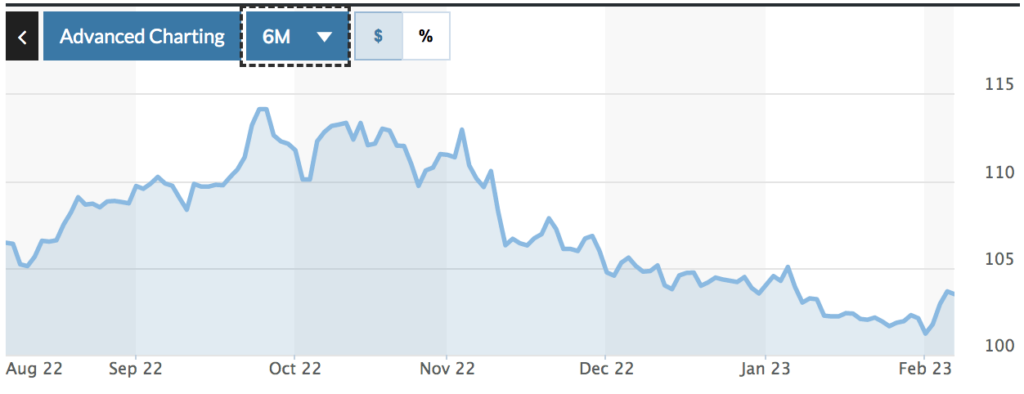- The US Dollar index (DXY) is up 1.3% in February.
- The DXY had fallen for four consecutive months before this improvement in February.
- Oil markets are down, providing a pathway to more growth in the technology sector.
Hitherto weaker US Dollar
Following the announcement of a slower rate-hike pathway by the US Federal Reserve, below their cadence of 0.5% per month, the US Dollar has been on a downward spiral.
Against a basket of international currencies (DXY), the US Dollar index fell over four consecutive months beginning in October last year.
While the Federal Reserve’s projected annualised rate hikes (0.25% per month * 12 = 3%) slipped below the forecast rate of inflation, the US dollar slid as investors sought better-yielding alternatives to protect the value of their portfolios.
DXY Chart:
Source:marketwatch.com
Top Australian Brokers
- Pepperstone - Trading education - Read our review
- IC Markets - Experienced and highly regulated - Read our review
- eToro - Social and copy trading platform - Read our review
Resurgent dollar
Several monetary and geopolitical factors have presented themselves over the last two weeks giving investors pause for thought on the US dollar’s slide.
1) Last week an extremely strong US nonfarm payroll number and multi-decade low unemployment reading had the market again concerned that the feedback loop of a tight labour market will pressure wage and service inflation.
Stubborn inflation will require additional Fed intervention and an even higher rate-hike path. The objective is to bring inflation to heel effectively. The potential rate-hike action will give the US dollar impetus and raise its valuation. It is the probability of this possible pathway that the market is currently anticipating.
2) Tensions with China over the recent balloon incident in the US have the market second-guessing itself on the level of cooperation that China and the US will exhibit post the Chinese COVID reopening.
It was hoped that China’s reopening would usher in a short-lived era of spending and economic prosperity that would spread globally. Unfortunately, the diplomatic incident has taken the shine off those prospects.
3) Energy markets are becoming exceptionally well-supplied, by the US, in particular, and several other market segments are joining this deflationary impact.
A slowing rate of climb and outright retracement of inflation in some countries may indicate that some assets are not comfortable with the current interest rate-hike pathway that is lowering their valuations relative to the US Dollar.
Outlook
It is too early to say whether a longer-term trend is emerging in the US dollar. It is quite possible that riskier and growth assets were overbought as exuberance over stalling inflation and the Chinese reopening clouded valuations. The current selloff in riskier assets may be a mean reversion rather than an overall change of tack.
The next few weeks will provide additional colour on the market’s direction. Further strong readings on US 2022 technology company earnings yet to report may well override any concerns the market may have about inflation.






